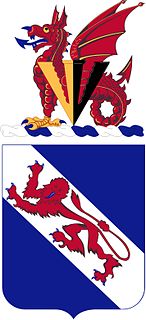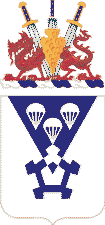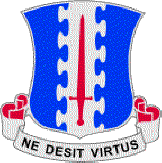
Airborne forces are ground combat units carried by aircraft and airdropped into battle zones, typically by parachute drop or air assault. Parachute-qualified Infantry soldiers serving in airborne force are also known as paratroopers.

The 82nd Airborne Division is an airborne infantry division of the United States Army specializing in parachute assault operations into denied areas with a U.S. Department of Defense requirement to "respond to crisis contingencies anywhere in the world within 18 hours". Based at Fort Bragg, North Carolina, the 82nd Airborne Division is part of the XVIII Airborne Corps. The 82nd Airborne Division is the U.S. Army's most strategically mobile division. More recently, the 82nd Airborne has been conducting operations in Iraq, advising and assisting Iraqi Security Forces.

Fort Benning is a United States Army post straddling the Alabama–Georgia border next to Columbus, Georgia. Fort Benning supports more than 120,000 active-duty military, family members, reserve component soldiers, retirees and civilian employees on a daily basis. It is a power projection platform, and possesses the capability to deploy combat-ready forces by air, rail, and highway. Fort Benning is the home of the United States Army Maneuver Center of Excellence, the United States Army Armor School, United States Army Infantry School, the Western Hemisphere Institute for Security Cooperation, elements of the 75th Ranger Regiment, the 1st Security Force Assistance Brigade, and other tenant units.

The 506th Infantry Regiment, originally designated the 506th Parachute Infantry Regiment during World War II, is an airborne light infantry regiment of the United States Army. Currently a parent regiment under the U.S. Army Regimental System, the regiment has two active battalions: the 1st Battalion, 506th Infantry Regiment is assigned to the 1st Brigade Combat Team, 101st Airborne Division, and the 2nd Battalion, 506th Infantry Regiment is assigned to the 3rd Brigade Combat Team, 101st Airborne Division.

The 187th Airborne Infantry Regiment (Rakkasans) is a regiment of the 101st Airborne Division.

The 508th Infantry Regiment is an airborne infantry regiment of the United States Army, first formed in October 1942 during World War II. The 508th is a parent regiment under the U.S. Army Regimental System, and two battalions from the regiment are currently active: the 1st Battalion, 508th Parachute Infantry Regiment is assigned to the 3rd Brigade Combat Team, 82nd Airborne Division, and the 2nd Battalion, 508th Parachute Infantry Regiment is assigned to the 2nd Brigade Combat Team, 82nd Airborne Division. The regiment served in combat during World War II, and regimental elements have served in combat in the Dominican Republic, Vietnam, Grenada, Panama, Iraq and Afghanistan.

The 502nd Infantry Regiment, previously titled the 502nd Parachute Infantry Regiment, is an infantry regiment of the United States Army. The regiment was established shortly after the American entry into World War II, and was assigned as a regiment of the 101st Airborne Division, "The Screaming Eagles", one of the most decorated formations of the U.S. Army. The regiment saw substantial action in the European Theater of World War II and was inactivated in 1945, shortly after the end of the war. Reactivating in a new form in 1956, the 502d Infantry has served in the Vietnam War, the first Gulf War, Operation Iraqi Freedom, Operation Enduring Freedom in Afghanistan, and Operation Inherent Resolve in Iraq. Since 1974, the regiment has been classified as an Air Assault unit. Currently, its 1st and 2nd battalions are active. Both battalions are assigned to the 2nd Brigade Combat Team, 101st Airborne Division.

The 503rd Infantry Regiment, formerly the 503rd Parachute Infantry Regiment and the 503rd Airborne Infantry Regiment, is an airborne infantry regiment of the United States Army. The regiment served as an independent regiment in the Pacific War during World War II; at Fort Campbell, Kentucky; in Okinawa, Japan; and in Germany. Regimental elements have been assigned to the 2nd Infantry Division, the 11th Airborne Division, the 24th Infantry Division, 25th Infantry Division, the 82nd Airborne Division, 101st Airborne Division, and the 173rd Airborne Brigade Combat Team. Regimental elements have participated in campaigns in the Vietnam War, Operation Enduring Freedom–Afghanistan, and Operation Iraqi Freedom. The regiment claims 15 Medal of Honor recipients: two from World War II, ten from Vietnam, and three from Afghanistan. A parent regiment under the U.S. Army Regimental System. The regiment's 1st and 2nd Battalions are active, assigned to the 173rd Airborne Brigade, based at Caserma Ederle, Vicenza, Italy. The 3rd and 4th Battalions as well as Companies E, F, G, H, and I have been inactived.
Colonel Edson Duncan Raff was a United States Army officer and author of a book on paratroopers. He served as Commanding Officer (CO) of the first American paratroop unit to jump into combat, the 2nd Battalion, 509th Parachute Infantry Regiment, near Oran as part of Operation Torch during World War II. His book, We Jumped to Fight, was based on his experience in that operation and was published in 1944.

The 509th Infantry Regiment is an airborne infantry regiment of the United States Army. The unit was initially activated as a single battalion, the 504th Parachute Infantry Battalion, in October 1941 at Fort Benning, Georgia. Nicknamed "Geronimo", the 509th conducted the U.S. Army's first combat jump during World War II on 8 November 1942, flying 1,500 miles from England to seize Tafarquay airport in Oran, Algeria. The 509th made a total of five combat jumps during the war.

The 505th Parachute Infantry Regiment, originally the 505th Infantry Regiment, is an airborne infantry regiment of the United States Army, one of four infantry regiments of the 82nd Airborne Division of the United States Army, with a long and distinguished history.

The 504th Infantry Regiment, originally the 504th Parachute Infantry Regiment, is an airborne forces regiment of the United States Army, part of the 82nd Airborne Division, with a long and distinguished history. The regiment was first formed in mid-1942 during World War II as part of the 82nd Airborne Division and saw service in Sicily, Italy, Anzio, the Netherlands, Belgium and Germany.

Robert Frederick Sink was a senior United States Army officer who fought during World War II and the Korean War, though he was most famous for his command of the 506th Parachute Infantry Regiment, part of the 101st Airborne Division, throughout most of World War II, in France, Holland and Belgium.

The 501st Infantry Regiment, previously the 501st Parachute Infantry Regiment and 501st Airborne Infantry Regiment, is an airborne forces regiment of the United States Army, with a long history, having served in World War II and the Vietnam War, both as part of the 101st Airborne Division, as well as the War in Afghanistan. It is the first airborne unit by designation in the United States Armed Forces. Its 1st Battalion is assigned to the 4th Brigade Combat Team (Airborne), 25th Infantry Division, located at Fort Richardson, Alaska. Its 2nd Battalion is assigned to the 1st Brigade Combat Team, 82nd Airborne Division, located at Fort Bragg, North Carolina.

The 3rd Battalion, 187th Infantry Regiment, also known as the Iron Rakkasans, is a battalion of the US Army 187th Infantry Regiment. The battalion was activated on 25 February 1943 and first saw action in the Pacific Theater of the Second World War, during the battle to regain US control of the Philippines. Troops from the battalion then served in the four-year occupation of Japan, where they earned their nickname "Rakkasans", before stationing in Fort Campbell, Kentucky. The battalion served in the Korean War from 1950 as the 187th Airborne Regimental Combat Team and participated in 12 major missions during the Vietnam War, emerging from that conflict as the US's most highly decorated airborne battalion. In 1992 they were designated as the "Iron" Rakkasans by Lieutenant Colonel David Petraeus due to his iron Rakkasan physical fitness test that added a fourth element of pull-ups to the standard APFT. The battalion has received numerous awards and commendations, including six Presidential Unit Citations and four Valorous Unit Awards.

The 511th Parachute Infantry Regiment was an airborne infantry regiment of the United States Army, first activated during World War II under Colonel Orin D. "Hard Rock" Haugen. It formed the parachute infantry element of the 11th Airborne Division. The full history of the regiment is the subject of the book, When Angels Fall: From Toccoa to Tokyo, the 511th Parachute Infantry Regiment in World War II (2019) by author and historian Jeremy C. Holm whose grandfather served in the regiment's Company D during the war.

The 2nd Battalion, 503rd Infantry Regiment is an active duty airborne infantry battalion in the United States Army, assigned to the 173rd Airborne Brigade Combat Team and stationed at Caserma Del Din, Vicenza, Italy. The battalion has served with the 2nd Infantry Division, the 11th Airborne Division, the 24th Infantry Division, The 25th Infantry Division, the 82nd Airborne Division, the 101st Airborne Division, and the 173rd Airborne Brigade; has been stationed in Korea, Germany, Italy and the United States; and earned campaign credits in World War II, the Vietnam War, Operation Enduring Freedom-Afghanistan, and Operation Iraqi Freedom.

The Landing at Nadzab was an airborne landing on 5 September 1943 during the New Guinea campaign of World War II in conjunction with the landing at Lae. The Nadzab action began with a parachute drop at Lae Nadzab Airport, combined with an overland force.

Major General Roy Ernest Lindquist was a highly decorated senior United States Army officer. He saw service during World War II and is most noted for his leadership of the 508th Parachute Infantry Regiment (PIR) during the campaign in Western Europe from June 1944 to May 1945.

The 1st Battalion, 503rd Infantry Regiment is an active duty airborne infantry battalion in the United States Army, assigned to the 173rd Airborne Brigade Combat Team and stationed in Vicenza, Italy. The battalion has served with the 2nd Infantry Division, the 11th Airborne Division, the 24th Infantry Division, the 82nd Airborne Division, and the 173rd Airborne Brigade; has been stationed in Korea, Italy and the United States; and earned campaign credits in World War II, the Vietnam War, Operation Enduring Freedom-Afghanistan, and Operation Iraqi Freedom.
Regiment as a Case Study," Monograph at the School of Advanced Military Studies, United States Army Command and General Staff College, Fort Leavenworth, Kansas, 2009.

















